Read Reviews
The Best Concrete Breakers
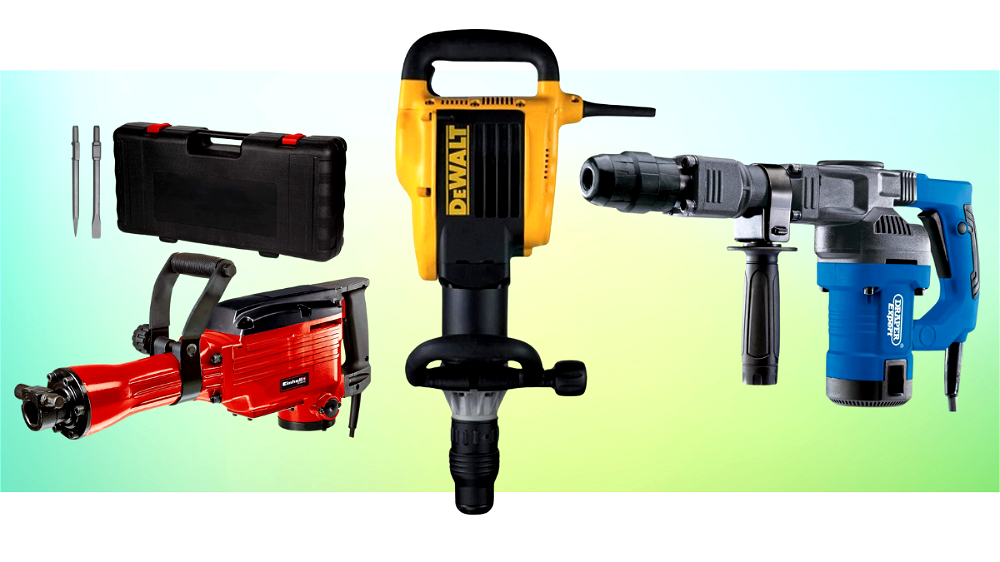
-
Einhell 4139087 Demolition Hammer TC-DH 43
-
Draper 81077 1050W SDS Max Breaker
-
DeWalt 240V 10Kg SDS-Max Breaker Demolition Hammer
-
VonHaus 1500W Electric Concrete Breaker
-
Laptronix Electric Demolition Concrete Breaker
-
ReaseJoy Heavy Duty Petrol Jack Hammer
-
Silverstorm 1500W Electric Concrete Breaker
Reviews
- Easily breaks up concrete and stone up to 20 cm thick
- Adjustable handle so you can use this demolition hammer in the most comfortable position
- Overall solid construction
- Comes with both a pointed and flat chisel included
- Case included to help with transportation
- Requires good upper-body strength to use safely
- Included case feels a little flimsy for a machine of this size and weight
- 3 m power cord likely to be too short to use without extension
- Not powerful enough for professional use
- Power
- 4
- Performance
- 4.5
- Ease of Use
- 4.5
- Value for Money
- 5
Whether you’re looking to break up concrete slabs, paving or tarmac, the Einhell 4139087 Demolition Hammer TC-DH 43 has sufficient power for the job. This electric concrete breaker is a great choice for domestic use, capable of tackling light to medium demolition work, as well as some heavy-duty tasks.
As a mains-powered model, this demolition hammer doesn’t have quite the same power as petrol powered tools, but it’s far easier to manage. It has 1600 W of power, and is able to break up thick concrete slabs and stone patios. There’s both a pointed chisel and flat chisel included, so it’s pretty versatile straight out the box. It’s also easy to switch between the chisels using the included SDS-hex tool chuck.
It has an additional handle partway down the shaft that can be adjusted 180°, enabling you to adopt any working position. This also means it can be used by people of different heights with no issues.
Overall, this demolition breaker comfortable to use, and easy enough to support, despite the 14.6 kg weight. It comes with a carry case included to help with transportation. One of the main downsides is the power cord – at just 3 m long, an extension will likely be needed most of the time.
Built using robust and quality parts, this is one of the best concrete breakers if you’re doing a lot of work around the home – it offers good value for money and will likely be more cost-effective than hiring a concrete breaker of the same power for more than a few days.
Did you find this review helpful?
- Weighs just 7 kg so more manageable than a lot of concrete breakers
- Can break through concrete up to 15 cm thick
- Great value choice for light/medium jobs (e.g., removing paving or concrete from fence posts)
- A more suitable choice for those new to using concrete breakers thanks to uncomplicated design and manageability
- Adjustable front grip allows you to use this breaker comfortably for long periods of time
- Gets fairly hot after periods of continuous use
- Two included chisels are a little short so you may wish to purchase a longer one separately
- Power
- 3.7
- Performance
- 4
- Ease of Use
- 5
- Value for Money
- 5
The Draper 81077 1050W SDS Max Breaker offers a happy medium when it comes to domestic concrete breakers. You’ll have minimal trouble lifting and using this demolition breaker, as it weighs just 7kg (which is a lot less than the other concrete breakers on this page).
With a 1050 W motor, this mains-powered demolition hammer isn’t the most powerful on this list. However, for lighter demolition jobs, it certainly holds its own. For this reason, it’s one of the best concrete breakers if you’re after something more beginner-friendly. Plus, the affordable price tag makes it even more tempting for those looking to tackle demolition work for the first time.
This demolition breaker is very easy to use thanks to a range of handy features. The anti-vibration rear handle helps prevent discomfort when used for long periods of time, and the trigger locking-switch ensures you don’t have to physically depress the trigger the whole time. Plus, for added comfort, the handle has a moulded soft grip.
As already mentioned, this concrete breaker isn’t too expensive so it’s a great option for those who have a few medium demolition jobs to tackle. It can easily break up concrete of around 15 – 20 cm thick so it is useful for the majority of home DIY projects.
Plus, as a lighter model, this demolition hammer is more manageable than other models featured here, so you may even use it more often! If you’re in the market for a light, manageable concrete breaker, the Draper SDS Max Breaker is my top recommendation.
Did you find this review helpful?
- The 10 kg weight means it's manageable for most users
- Cuts through thin slabs of concrete with ease
- Ergonomic design is easy on the hands and limits vibration
- Small handle means it can be used in tight spaces
- There is no chisel included so a separate purchase is needed before you can use it
- Has to chip away at larger blocks of concrete
- Having to buy chisels separately makes this unit quite expensive
- Power
- 4.3
- Performance
- 4
- Ease of Use
- 4.5
- Value for Money
- 4
Using the DeWalt 240V 10Kg SDS-Max Breaker Demolition Hammer to break up concrete is a far cry from the days of slinging a sledgehammer around; this electric-powered demolition hammer is so much easier on the hands and back than the old-fashioned method, and saves a lot of time too.
With an ergonomic main handle, and a side handle that can be positioned anywhere on the hammer barrel, it’s simple to find a position that suits you without having to just rely on the factory settings. The 10 kg weight is also pleasantly (and surprisingly) light for such a powerful machine, so it’s not difficult to support as it drives into whatever paving you’re keen to destroy.
Built with magnesium housing, demolition hammer is manageable yet tough. Vibration is also kept to a minimum, and these factors combine to result in a concrete-breaking experience that won’t break your spirit.
Changing the position of the chisel can be done quickly, and there are 12 pre-set positions to choose between; the main thing to mention here is that chisels will need to be bought separately, otherwise you’ll be disappointed when your new machine arrives and you can’t immediately give it an inaugural test drive.
This demolition hammer will get through smaller concrete slabs, and chip away at larger block of concrete without faltering – as a mains-powered demolition hammer there’s no reason to stop until the job is done, so it’s a reliable tool to have around whether you’re taking apart a patio, or demolishing a concrete drive.
It also comes with a carry case that stores the demolition hammer as well as any separately-purchased drill bits, so storage is easy and nothing gets lost.
Did you find this review helpful?
- Can break through concrete slabs that are 22 cm thick
- Well constructed with very stable and robust parts
- Arrives prefilled with oil so can be used straight out of the box
- Comes with two chisels as well as a range of accessories
- Handle rotates 360° for user comfort
- Included carry case is a little flimsy given the size of this concrete breaker
- Reasonably heavy at over 20 kg so can become tiring with prolonged use
- Shock absorption is relatively weak. This demolition hammer becomes uncomfortable to use due to the vibrations
- Power cable it short at just under 2 m
- Power
- 4.3
- Performance
- 5
- Ease of Use
- 4.2
- Value for Money
- 4.2
The VonHaus 1500W Electric Concrete Breaker is designed for tackling brick, blockwork, asphalt and concrete. It’s a mains-powered model, so doesn’t require the same maintenance as petrol tools, yet it still boasts an impressive 1500 W of power.
Capable of delivering 1500 blows per minute, with an impact force of 45 joules, this demolition hammer is suitable for most domestic demolition tasks. The power comes at no cost to comfort, as it also has a side handle that can be adjusted through 360° to offer the user ample control.
Extra features ensure this concrete breaker can be used straight out of the box; it arrives pre-filled with oil and comes with both a pointed and a flat chisel. There’s also an included carry case which, although a little flimsy for such a large tool, can be used to transport the demolition breaker easily from the shed to wherever it’s required.
For added convenience, it also comes with an oil bottle, socket-head wrench, 3 hex keys and a carbon brush included.
Weighing over 20 kg, you can’t really say that this concrete breaker is ‘lightweight’. But, thanks to the adjustable handle, it remains relatively easy to use – as long as you have sufficient strength to control it. The weight helps with breaking up the concrete, and it can break through areas that are at least 22 cm thick.
Aside from the weight, there is another downside when it comes to ease of use with this demolition breaker – the shock absorption. It produces a lot of vibration, especially when used for heavy duty work; therefore, a thick pair of gloves are a must.
All things considered, this is one of the best concrete breakers if you’re after a reasonably heavy-duty tool for DIY. It comes with a range of accessories included so it can be used straight out of the box, and it is capable of working through thick concrete.
Did you find this review helpful?
- Can break through concrete of 30 cm in thickness
- Comes filled with oil so can be used straight out of the box
- 3 different chisels included for versatility
- Safety gear provided - gloves, goggles and a mask
- Case has roller wheels attached for easy transportation
- 23 kg weight can be hard to support for long periods
- No indication in instructions as to what type of oil needs to be used
- Power
- 5
- Performance
- 5
- Ease of Use
- 3.8
- Value for Money
- 4
If you’re looking to tackle heavy demolition work, the Laptronix Electric Demolition Concrete Breaker is a great option. Designed primarily for heavy demolition, masonry and chiselling work, this demolition hammer is very versatile. In most cases, it will be more cost-effective than hiring a demolition breaker of the same power for a day or two.
With a 1700 W motor, and a demolition capacity of 40.5 joules, this demolition breaker is capable of tackling thick slabs of concrete between 20 – 30 cm. It comes with both a 410 mm point chisel, a 410 mm flat chisel and a 410 mm U chisel so it’s capable of managing a variety of tasks. These are useful whether you’re chipping tiles, breaking up floors, or knocking down walls.
One thing that does impact the ease of use, however, is the weight. At 23 kg, this concrete breaker can get tiring to support. However, it also gets to work very quickly, limiting the amount of time you need to hold it for.
The handgrip is comfortable and ergonomic, while the GAN-HEX tool mount allows for a quick and safe chisel change.
Not only is this a strong demolition hammer with plenty of power, but Laptronix have also considered safety when it comes to this concrete breaker. There are gloves, goggles and a mask included.
Overall, this is one of the best concrete breakers if you’re after power but don’t want to use a petrol-powered tool. It’s basically as strong as you’ll need for the majority of DIY work.
Did you find this review helpful?
- The carrying case and wheels are a welcome extra feature, helping you to transport the 15kg breaker around the garden
- Well built, with quality steel components
- The rubber grip reduces vibration for a more comfortable experience
- May need occasional rests to avoid overheating
- The addition of petrol adds to the already heavy weight of the unit
- The carry case handle isn't particularly ergonomic
- The instruction manual lacks information
- Power
- 4.5
- Performance
- 4
- Ease of Use
- 4
- Value for Money
- 4.2
Electric motors are great, thanks Michael Faraday, no-one is denying that. But, when it comes to concrete breakers, sometimes the added oomph of a petrol engine is what’s needed to get the job done.
Even from just looking at the ReaseJoy Heavy Duty Petrol Jack Hammer, it’s clear to see that this 52 cc demolition hammer isn’t messing around – its steel construction and compact engine look both professional and hardwearing.
And then, when it comes to performance… the phrase ‘like a hot knife through butter’ comes to mind…
Clearly, we’re talking about a much more powerful demolition hammer than the electric models featured on this list; this is the best concrete breaker for tougher jobs – it’ll easily get through two feet of concrete without stuttering, and doesn’t hold you back with any restrictive power cable.
The shock-mounted handles help absorb vibration, adding some cushioning for your hands whilst using the machine. This helps to reduce fatigue and discomfort, which is further helped by the position of the two handles.
The handles are placed slightly differently than other models, with both at the top of the machine instead of one further down, and they help push down the 23.8 kg breaker through concrete surfaces.
Granted, you may find that this ~24 kg machine is slightly more difficult to control than lighter models, depending on your build, but when used vertically the weight seems to aid the impact energy and performance.
It’s a case of knowing your strength, and deciding if you can manage the weight of this demolition hammer.
A flat and pointed chisel come included, as well as a steel case and tool kit. A canister also comes with the breaker, to aid in the mixing of the 25:1 gasoline to engine oil solution – the tank holds 1.3 L of fuel, which adds approximately 1 kg of additional weight.
Did you find this review helpful?
- The weight minimises the vibrations for more comfortable usage
- Comes with a blade and pointed chisel so you can get started straight away
- The build is good quality and durable
- The transportation case and wheels ensure it's easy to move this breaker in and out of storage
- Smaller users may find this demolition hammer a little heavy
- Some users find the bolts loosen after a short period of use
- May not be suitable for heavy demolition work
- Power
- 4
- Performance
- 4
- Ease of Use
- 4
- Value for Money
- 4
There comes a point when renting power tools just doesn’t make economic sense, especially when you’re getting stuck into a long job or serious garden renovation. But, of course, then there’s the issue of trying to find something that will match a rental machine’s power, without costing an arm and a leg.
Fortunately, the Silverstorm 1500W Electric Concrete Breaker really stands up, performance-wise, to the breakers that you would rent from a hardware store. If you’re digging out concrete fence posts, breaking apart brick walls, or tearing up driveways, this 1500W tool won’t abandon you partway through the job.
With several features designed for improved comfort, this is a good companion for medium-size jobs. The vibrations are kept down thanks to the demolition breaker’s ergonomic handles. These have rubber grips to minimise shock, and the position of the lower handle can be changed too. Depending on your preferred working position, you can move the lower handle through 360° to get ensure a good grip on the unit, even when working at different angles.
Plus, I know we all love a bargain (we’re only human), so it’s also quite satisfying to realise that this demolition breaker only costs the same as renting one for a couple of weekends. And, you get some extras included as well, like a chisel bit, wrench, and steel carry case.
It’s one of those tools that makes you think – well, even if I only need to use it a couple of times, I can loan it out to friends and it will continue being a worthwhile purchase for years.
A final thing to note, which is worth bearing in mind, is its weight. At 16 kg, it’s one of the heaviest units featured on this list, which might mean it’s not the best concrete breaker for those who struggle to work with heavy power tools for extended periods (given that there are lighter options available).
But, as mentioned, it does have some features that help with comfort during use, so it’s isn’t going to be the most uncomfortable machine either.
Did you find this review helpful?
How to Choose The Best Concrete Breaker
How to Use a Concrete Breaker
There are a few ways to go about using a concrete breaker to make sure you get the most out of it.
Bear in mind that power will change the type of approach you need to take; you can’t expect them all to work in exactly the same way. More powerful demolition breakers will break concrete even if you start in the middle of a slab, whereas other models will require you to start at the edge.
So, here’s some general advice on how to use an electric demolition breaker. Of course, you must always follow the manufacturer’s instructions and wear the appropriate safety equipment:
- Use an electric breaker to break concrete which is around 10 – 20 cm thick (some demolition breakers may be able to cope with up to 30 cm).
- Ensure that the chisel is securely positioned before starting the job.
- Make sure that the cable is always out of the way – you don’t want to accidentally cut through it.
- If you want to create a straight line, use a flat chisel blade. If you’re just looking to break the concrete up, a pointed chisel will do.
- To break up concrete on the floor (paving slabs, etc.), use the breaker vertically.
- Start at the edge of the concrete and work your way in.
- Don’t use the chisel blade as a lever to remove broken concrete – use a crowbar or other tool for this.
Choosing the Right Level of Power
Demolition hammers come in a range of sizes and have varying power levels.
Higher powered tools can make the job easier, but they can also be a lot heavier. It’s highly recommended to look at the weight of the concrete breaker before committing to purchase the most powerful tool you can find!
If you plan on using the tool vertically, a lighter demolition hammer will be both safer and easier.
The power of the motor is measured in watts. Those with a more powerful motor will be able to tackle heavy demolition work, while hammer breakers with a motor of 1500W or less are best for light to medium tasks.
Petrol vs Electric Powered
Both petrol-powered and electric-powered concrete breakers are available. There are pros and cons to each design.
Petrol-Powered Concrete Breakers
Petrol concrete breakers are often extremely powerful due to their petrol motors. Plus, they are portable – you don’t need to use them connected to an external power supply so they can be used even in places where there’s no electricity.
However, petrol concrete breakers are generally heavier than electric models and can cost more to run because of their need for fuel. Petrol-powered demolition breakers also tend to require more maintenance than electric ones.
Electric Demolition Breakers
Electric demolition breakers are generally cheaper than petrol-powered models. They often tend to be lighter as well, making them easier to use/ They’re sufficient for light/medium jobs but not cut out for for heavy-duty tasks. They are cheap to run, but do have the drawback of requiring mains power.
Depending on the voltage of the electric-powered demolition hammer, you may need to use a step-down transformer. This will be required if the voltage of the power tool is lower than the voltage of the power supply. Many professional power tools have a voltage of 110 V to make them safer. However, home voltage output may be closer to 240 V. A step-down transformer will allow only 110 V to be provided to the machine.
The Importance of Quality
Concrete breakers can be dangerous if they are not properly maintained. It’s worth spending a bit more money on a high-quality concrete breaker from the outset, rather than it costing you in repairs down the line.
Look for a demolition hammer with a quality build construction. Most have either an aluminium or magnesium casing.
It’s a really good idea to make sure that the concrete breaker is fully serviceable and that replacement parts are easy to source. Researching this before committing to a purchase can save money in the long run.
Comfort and Ergonomics
Concrete breakers create a huge amount of vibration, and those with a more powerful motor can be uncomfortable to use.
Certain features can help improve shock absorption which can make the demolition hammer more comfortable to use. Look for shock mounted handles that can absorb vibrations. These will allow for longer use with reduced fatigue.
Make sure you are wearing all the necessary safety equipment when using your demolition hammer.
Take Note of Included Parts
Concrete breakers usually come with some parts and tools included which can be easily changed.
A flat chisel and pointed chisel are the most common included chisels as they are great for basic concrete breaking.
If you’re using your tool for a range of applications, you may want to purchase a full set of chisels.
Here are the different types of chisel and what they’re used for:
Spade – this bit creates an edging in asphalt or creates a flat finish on concrete.
Bull point bit – this tip is used for general demolition of concrete.
Flat tip chisel – this chisel allows for a finer edge finish and increases direction control.
Stake driver – this bit is used to drive concrete from stakes.
Flex chisel – this chisel is handy for tile removal and scraping.
Bushing tool – this tool is handy for knocking down rough spots in concrete and cleaning up seams.
A U chisel – this chisel is perfect for chasing out concrete for electrical work.
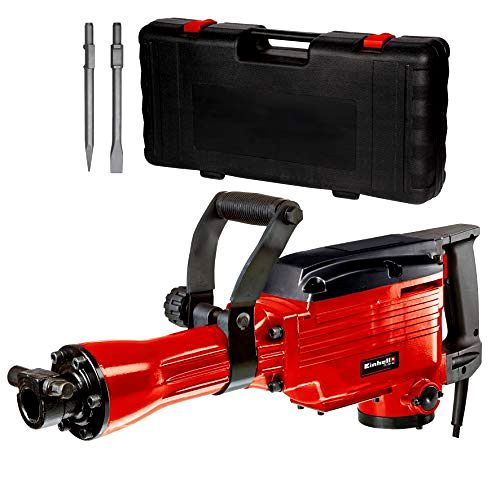
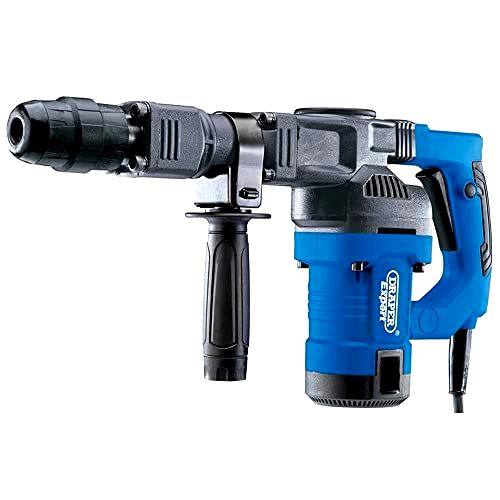
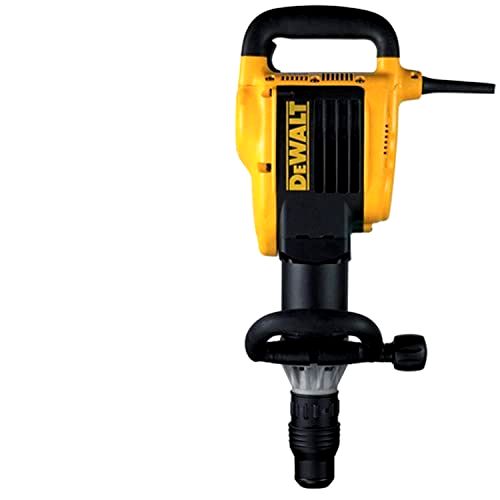
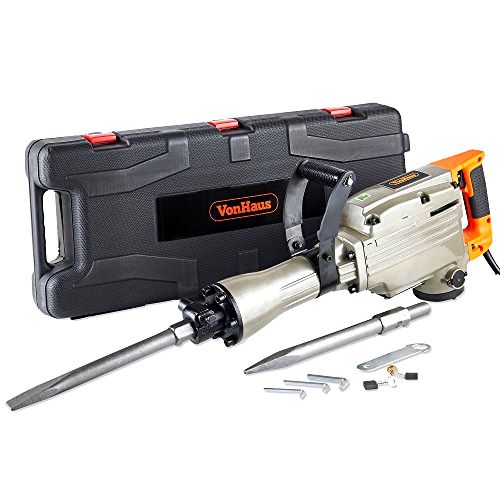
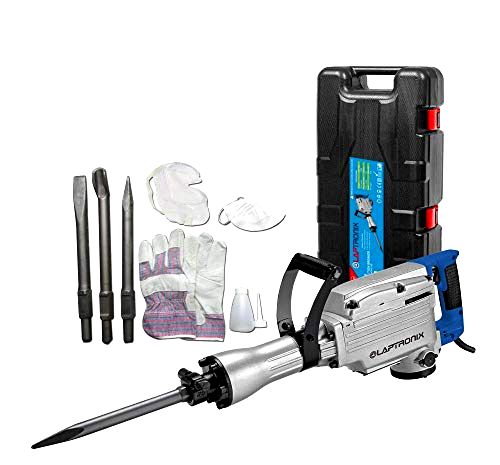
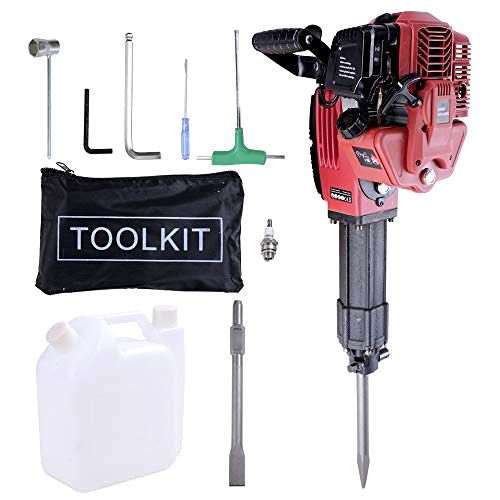
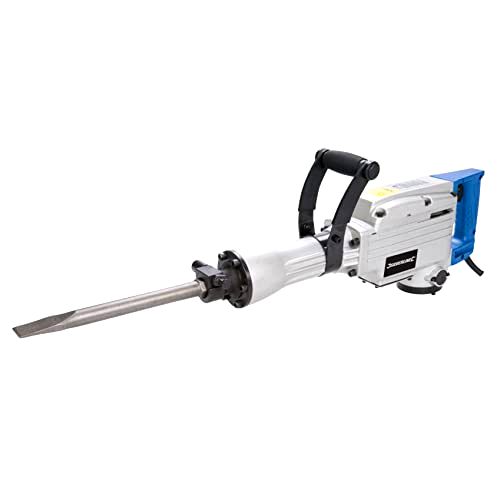

Share